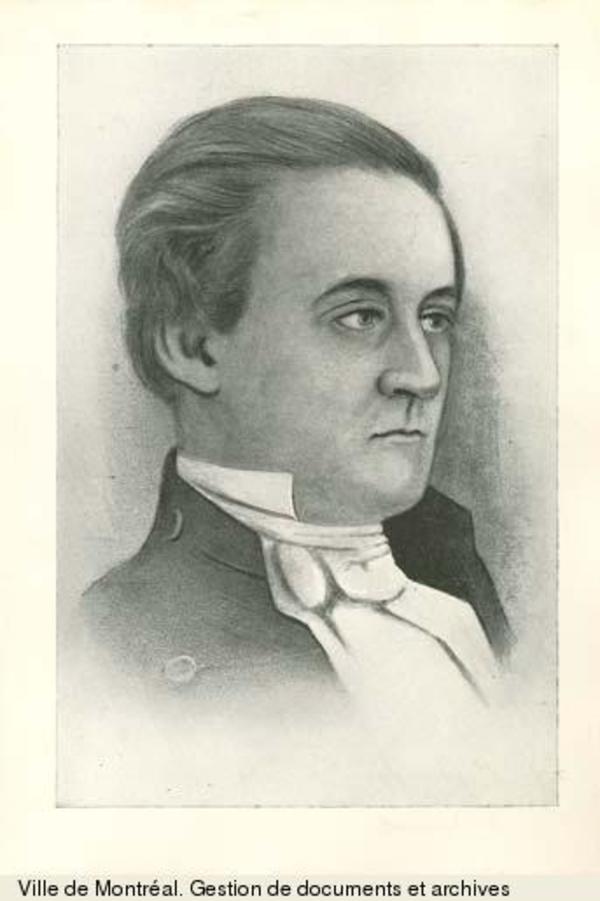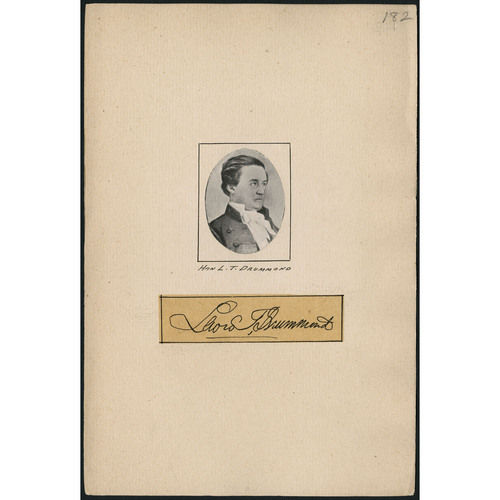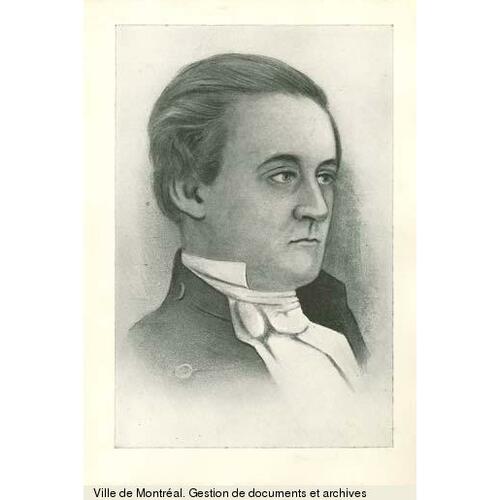
Source: Link
DRUMMOND, LEWIS THOMAS, lawyer, politician, and judge; b. 28 May 1813 at Coleraine (Northern Ireland), son of Lewis Drummond; d. 24 Nov. 1882 in Montreal, Que.
Lewis Thomas Drummond, the son of a prominent Irish attorney, immigrated to Lower Canada with his widowed mother in 1825 and was educated at the Séminaire de Nicolet. He then studied law in the Montreal office of the prominent Tory attorney, Charles Dewey Day, and in 1836 was admitted to the bar of Lower Canada. Drummond established his own practice in Montreal where he quickly gained renown with his able defence of the Lower Canadian rebels in 1838. His oratorical abilities in both English and French (Joseph-Édouard Cauchon was to say that he combined the Irish richness of imagination with the cold reason of the German) led him to politics as early as 1840, when he became a supporter of the Reformers under Louis-Hippolyte La Fontaine*. In September 1842 Governor Sir Charles Bagot* chose La Fontaine to lead the government of the united province, and the latter entrusted the dispensation of patronage in Montreal to his lieutenant, Drummond. In the municipal elections of December 1842 held to replace the city council appointed by Lord Sydenham [Thomson*], the La Fontaine party emerged with a majority of two members, though Drummond was personally defeated.
The political strategy of La Fontaine, who united his forces with the Upper Canadian Reformers led by Robert Baldwin* in the pursuit of responsible government, met with difficulty after Bagot was replaced in March 1843 by Sir Charles Theophilus Metcalfe*. In November of that year La Fontaine and the members of the cabinet, with the exception of Dominick Daly*, resigned en bloc after serious disagreements with Metcalfe, and Montreal became a testing ground for Lower Canada’s adherence to the political struggle for responsible government. A faction led by Denis-Benjamin Viger* and Denis-Benjamin Papineau* supported Metcalfe because they felt that French Canadian interests would be better served not by an alliance with Upper Canadian Reformers but by trusting in a benevolent and open-minded governor to make decisions based on a clear distinction between the wishes of the parliamentary majorities from Canada East and Canada West.
Both sides regarded the Montreal by-election of April 1844 as a prelude to the general election expected later that year. Drummond became the La Fontaine candidate, while Viger’s followers allied themselves with the Tory candidate, William Molson*, thus seriously compromising their “autonomiste” and nationalist appeal. In the violent election which ensued, Drummond and his organizer, Francis Hincks, united two groups of arch-rivals, the French Canadian and the Irish workers on the Lachine Canal and on the docks, and used the latter to rule the polling stations physically; Drummond was declared the winner by a large majority.
La Fontaine’s party won an easy victory in the 1844 general elections, but Drummond ironically lost his seat in Montreal, in part because the fickle Irish canal workers had sold their services to the Tory side. Cauchon found him an uncontested seat in Portneuf, near Quebec City, and Drummond continued to campaign among the Montreal Irish in the interests of his party. In the assembly Drummond, who had been appointed to a commission inquiring into riots among workers on the Lachine Canal, championed the cause of Irish labourers whose oppression by employers, he said, goaded them into violence. Nevertheless he supported the mobilization of a mounted police force to keep the peace at public works projects and argued that since canal workers had no property to protect they should be deprived of arms. When he demanded compensation for pardoned Lower Canadian rebels of 1837–38 who had suffered loss of property, he argued that they had been ignorant of the implications of their actions, in an admittedly unjustified armed uprising. His cultural and religious identification with these groups (no doubt strengthened by political opportunism) was clearly not accompanied by any radical tendencies on his own part. In fact Drummond allied himself with the conservative French Canadian élite in 1842 by marrying at Saint-Marc Josephte-Elmire, the eldest daughter and heiress of Pierre-Dominique Debartzch*, a seigneur and former legislative and executive councillor.
Drummond also became a favourite of the Roman Catholic hierarchy. To help counterbalance the influence of his opponent Viger at the bishop’s palace, in 1846 he defended the church’s claim to the Jesuits’ estates and in 1852 was instrumental in overcoming Upper Canadian opposition to the incorporation of the Jesuits’ Collège Sainte-Marie in Montreal. (Drummond’s sons, Lewis and Charles, attended the college and eventually joined the Jesuit order.) At the same time Drummond was an enthusiastic advocate of commerce and industry. Already an investor in some valuable Montreal real estate, in 1842 he became one of three directors of the Montreal City and District Savings Bank, which was seen by French Canadians as a step towards their sharing in the return of prosperity. Three years later he bought shares in the Société de Navigation de la Rivière Richelieu, which grew into a major St Lawrence River shipping firm by the 1850s [see Jacques-Félix Sincennes*]. In 1847 he became a shareholder in the St Lawrence and Atlantic Railroad and helped found the Garden River Mining Company. During the late 1850s he was president of the Stanstead, Shefford and Chambly Railroad, and finally, in 1859, he was an incorporator of the Transmundane Telegraph Company. Though Drummond did occasionally find himself in straitened financial circumstances, he was at least a junior member of Montreal’s business élite.
To a certain degree, Drummond embodied the post-rebellion alliance between those French Canadian nationalists who became the “bleus” and the English-speaking business community. But he did not fit neatly into either group, nor was he able to marshal a unified Irish following, which may explain why he never again represented a Montreal constituency after 1844. In 1848, when Baldwin and La Fontaine were returned to power, Drummond was elected in Shefford, an isolated, English-speaking, Protestant county in the Eastern Townships. Still, he continued to handle patronage in Montreal. From 7 June 1848 he was solicitor general for Canada East without a cabinet seat, and he ruthlessly used the patronage power to deprive annexationists in Montreal and the Eastern Townships of their public offices. He grew so concerned about the spread of annexationist sentiment that he advocated the dispatch of a greater number of British troops to Canada and the mobilization of a mounted police force to reinforce the local magistrates.
Drummond had not, in fact, forgotten his liberal principles for, after the annexation crisis dissolved in 1850, he played a key role in the long overdue reforms of the land-holding system in Canada East, particularly when he became attorney general for Canada East in the Hincks–Augustin-Norbert Morin* government formed in October 1851. The previous year he actually came into conflict with La Fontaine by advocating the secularization of the clergy reserves; he worked on bills to reform municipal institutions and road construction, as well as the seigneurial system. Under existing legislation, censitaires could voluntarily switch to freehold tenure, but they had to compensate the seigneurs for loss of their dues and services. Though himself a seigneur through his wife, Drummond proposed legislation in 1852 which would limit certain seigneurial privileges and place a ceiling on the steadily increasing cens et rentes (annual rent). The seigneurs would be indemnified from public funds for some of their losses. The English-speaking commercial group objected that the lower dues would not only drastically reduce the value of their seigneuries, but would perpetuate a system which interfered with commerce and industry by removing the incentive for censitaires to commute to freehold tenure. Drummond’s bill was accepted by the assembly but rejected by the Legislative Council in May 1853. In September 1854 the Hincks–Morin government was succeeded by a new administration formed by Morin and Sir Allan Napier MacNab*, and later that year Drummond, who retained the post of attorney general East, and his French Canadian colleagues were forced by pressure from Canada West to accept extensive modifications in the bill.
The new provisions literally turned Drummond’s bill upside-down by abolishing seigneurial tenure, while doing little to improve the financial situation of the habitants. Rather than being lowered as initially proposed, the current cens et rentes and casual dues (whose value on each seigneury was to be fixed by a commission) became the basis for the price which a former censitaire would have to pay to the seigneur in order to gain full ownership of his farm. Because the vast majority could not afford such a price, they paid in its stead an annual constituted rent (the annual interest charge against the value of their property), thereby remaining in basically the same subservient position as before. The true beneficiaries were the commercial and industrial entrepreneurs of Canada East: as former seigneurs, under the 1854 law their annual rents would not diminish and a government indemnity fund would compensate them for loss of the lods et ventes (the charge of one-twelfth the selling price exacted to the benefit of the seigneur when a censitaire’s farm changed hands); as capitalists, it was now easier for them to speculate in land, to control timber reserves, and to build mills at water sites within the old seigneuries.
Drummond’s inability to have the seigneurial system reformed as he would have liked had inevitable political consequences. In failing to aid the censitaires he could no longer appear as a “friend of the people,” nor, on the other hand, could he take credit for the legislation among the English-speaking business interests who ultimately benefited from it. The Anglo-Protestant community had been further alienated in 1853 when neither Montreal municipal authorities nor Drummond’s office of the attorney general succeeded in controlling Catholic rioters who were protesting the presence of the crusading apostate, Alessandro Gavazzi. Not surprisingly, therefore, John A. Macdonald* had little difficulty’ in blocking Drummond’s attempt to become co-premier with him in May 1856, and formed instead a ministry with Étienne-Paschal Taché*. When Drummond carried through his threat to resign as attorney general, Macdonald and Taché simply replaced him with George-Étienne Cartier* in the new government. Drummond’s disaffection with the “bleu” party grew until 1858, when he switched sides to become attorney general for Canada East in the short-lived ministry of George Brown* and Antoine-Aimé Dorion*. By this time, local grievances in his riding of Shefford, such as his failure to win a judicial district for the area, had culminated in a vocal demand for representation by a Townships resident. Drummond was defeated in Shefford by Asa Belknap Foster* in August 1858 and forced to take a seat in Lotbinière.
During Drummond’s later years in opposition to the Macdonald–Cartier government, his strong identification with Canada East occasionally brought him into conflict with George Brown, the powerful leader of the Reformers. In 1859, for example, Drummond was spokesman for 12 Lower Canadian Reformers who expressed resentment at Brown’s vociferous attack on Cartier’s bill to apply additional common revenues for the compensation of seigneurs. In spite of growing coldness between the two wings of the Reform party, however, Drummond was never willing to support a return to separate status for the two sections of the province. Instead he became a champion of their federation.
In 1862 Drummond was able to support a ministry more in tune with his middle-of-the-road political philosophy, that of John Sandfield Macdonald* and Louis-Victor Sicotte. However, in May 1863 he was asked to join A.-A. Dorion and his Rouge supporters in replacing Sicotte and his moderate followers in the cabinet; he thus took over from Thomas D’Arcy McGee*, the previous Irish representative. Unfortunately for Drummond he had to resign his public works portfolio when he failed to win in two by-elections in Rouville, which he had represented since 1861. This loss effectively ended his political career. In March 1864 the Macdonald–Dorion government appointed Drummond to a long-coveted position as a puisne judge of the Court of Queen’s Bench. After a notable judicial career, Drummond was forced to retire in 1873 because of ill health. He subsequently was active in the St Vincent de Paul Society until his death from chronic bronchitis in 1882.
BNQ, mss-101, Coll. La Fontaine (copies at PAC). DCB, Fichier André Garon. McGill Univ. Libraries (Montreal), Dept. of Rare Books and Special Coll., “Legislative bills and newspaper discussions concerning seigniorial tenures act, 1851–54.” MTL, Robert Baldwin papers. PAC, MG 24, B40. Can., Prov. of, Legislative Assembly, Journals, 1854–55; Statutes, 1854–55, c.3. Debates of the Legislative Assembly of United Canada (Gibbs et al.), I–VIII. Documents relating to the seigniorial tenure in Canada, 1598–1854, ed. W. B. Munro (Toronto, 1908). Christopher Dunkin, Address at the bar of the Legislative Assembly of Canada, delivered on the 11th and 14th March, 1853, on behalf of certain proprietors of seigniories in Lower Canada . . . (Quebec, 1853). [Francis Hincks], The seigniorial question: its present position (Quebec, 1854). Commercial Advertiser (Montreal), 1853. Le Courrier de Saint-Hyacinthe, 1854. L’Ère nouvelle (Trois-Rivières), 1853. La Minerve, 1854. Montreal Gazette, 1851, 1853–54. Montreal Herald and Daily Commercial Gazette, 1853, 1882. Morning Chronicle (Quebec), 1853. Toronto Patriot, 1851. Borthwick, Hist. and biog. gazetteer. J. Desjardins, Guide parl. J. P. Noyes, Sketches of some early Shefford pioneers ([Montreal], 1905). P.-G. Roy, Les juges de la prov. de Québec. R. B. Burns, “D’Arcy McGee and the new nationality” (ma thesis, Carleton Univ., Ottawa, 1966). Careless, Brown; Union of the Canadas. Dent, Last forty years. R. C. Harris and John Warkentin, Canada before confederation; a study in historical geography (Toronto, 1974). D. A. Heneker, The seigniorial regime in Canada (Quebec, 1927). Monet, Last cannon shot. W. L. Morton, The critical years: the union of British North America, 1857–1873 (Toronto, 1964). O. D. Skelton, The life and times of Sir Alexander Tilloch Galt (Toronto, 1920). T. P. Slattery, Loyola and Montreal (Montreal, 1962). G. J. J. Tulchinsky, The river barons: Montreal businessmen and the growth of industry and transportation, 1837–53 (Toronto and Buffalo, N.Y., 1977). G.-É. Baillargeon, “À propos de l’abolition du régime seigneurial,” RHAF, 22 (1968–69): 365–91; “La tenure seigneuriale a-t-elle été abolie par suite des plaintes des censitaires?”RHAF, 21 (1967–68): 64–80. J.-C. Bonenfant, “La féodalité a définitivement vécu,” Rev. de l’univ. d’Ottawa, 47 (1977): 14–26. Jacques Monet, “La Crise Metcalfe and the Montreal election, 1843–1844,” CHR, 44 (1963): 1–19.
Cite This Article
J. I. Little, “DRUMMOND, LEWIS THOMAS,” in Dictionary of Canadian Biography, vol. 11, University of Toronto/Université Laval, 2003–, accessed January 18, 2026, https://www.biographi.ca/en/bio/drummond_lewis_thomas_11E.html.
The citation above shows the format for footnotes and endnotes according to the Chicago manual of style (16th edition). Information to be used in other citation formats:
| Permalink: | https://www.biographi.ca/en/bio/drummond_lewis_thomas_11E.html |
| Author of Article: | J. I. Little |
| Title of Article: | DRUMMOND, LEWIS THOMAS |
| Publication Name: | Dictionary of Canadian Biography, vol. 11 |
| Publisher: | University of Toronto/Université Laval |
| Year of publication: | 1982 |
| Year of revision: | 1982 |
| Access Date: | January 18, 2026 |




